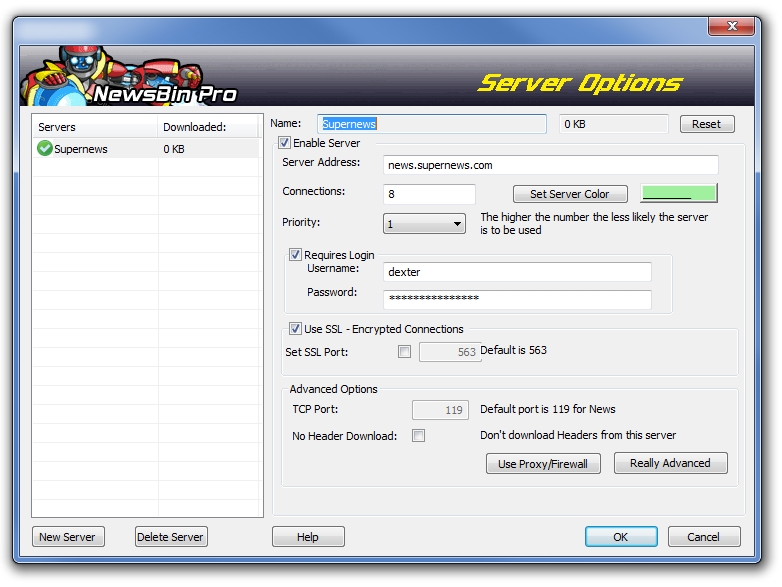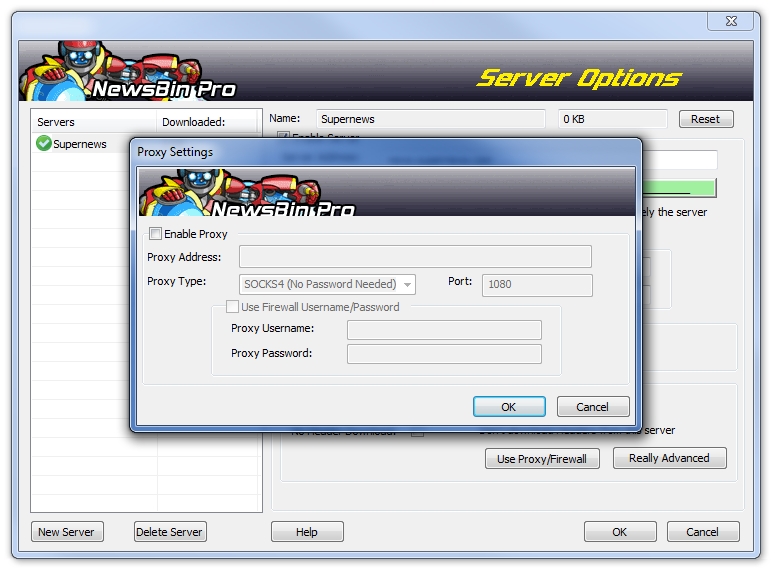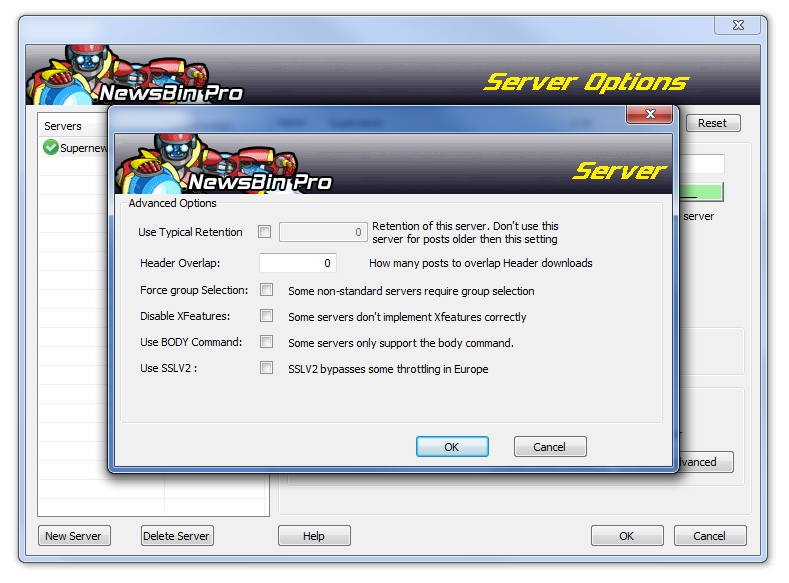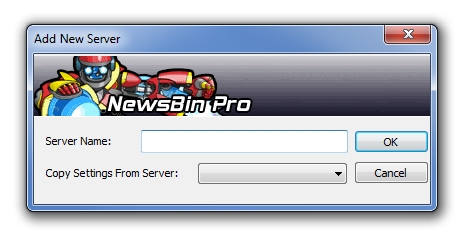V650-ServerOptions
From Newsbin
Version 6.50 Help Page | Newsbin Forums | Troubleshooting FAQ | Usenet Glossary | Newsbin Beta Page
Contents |
Server Options
Server Address
Your Usenet news service provider will give you the address to use to connect to the server. Usually it starts with "news" at the beginning. Some examples are:
news.astraweb.com ssl.astraweb.com **NOTE** some servers have a different address if you are using SSL news.supernews.com news.usenetserver.com
Connections
Select the number of simultaneous connections to use for this server. The default in Newsbin is 8 connections. Most services have a limit and this value is under the average limit so you should be safe. We recommend running only as many connections as needed to get your highest line speed. Using more connections unnecessarily can result in slower download speeds due to the extra resources on your computer needed to maintain all the connections.
Priority
Newsbin supports server prioritization. The first priority servers should be set at Priority 1. Setting a server to a lower priority (higher number) tells Newsbin to only use this server if no other servers of higher priority has a specific post (chunk). Older versions of Newsbin called this a "Fill Server". Newsbin will try every other server of higher priority in your server list and, when all else fails, will use the lower priority servers. This is most effective if you choose servers that provide block usage (i.e. pay for a certain amount of download in advance) to serve as backup if your primary server (preferably unlimited download server) is missing some critical posts.
Uses for Fill Servers are:
- Maximize use of free servers and use pay servers only if needed.
- Limit use of servers with download limits.
Login
Your Usenet news service provider will send you the username and password to use in order for Newsbin to connect to their servers. This is not provided by us when you purchase a key to Newsbin. News server login info is only available from your Usenet provider.
SSL Support
To have Newsbin use an SSL connection (Secure Socket Layer), check the "Use SSL" box.
The default port for SSL NNTP connections is 563. To select a different port, check the "Set SSL Port" box and enter the port number for Newsbin to use.
SSL enabled servers will have a padlock icon indicator in the Server tab. To verify SSL is turned on, "Show Server Commands" must be enabled under Options/Network, and "Verbose" selected in Options->Advanced. Then in the Logging tab you will see a message like this:
[12:34:56] Level: LOW MODULE=InterSocket, MSG=SSL Connection Server: ssl.astraweb.com Stats AES256-SHA 256 Bits Version: TLSv1/SSLv3
Once SSL is enabled, every connection to this server will be encrypted with the same technology used to provide security for websites. SSL for Usenet is also referred to as NNTPS.
Newsbin must be restarted after enabling SSL or changing the SSL port setting
Advanced Options
The default TCP port for NNTP is 119. You normally don't need to change this unless you plan to run on an Alternate Port or through a Tunnel. Many ISP's are now limiting your speed for Usenet access. They do this by putting a limit on internet traffic using port 119, which is standard for Usenet. Many news servers provide Usenet access on alternate ports that are set aside for different protocols like telnet, mail, web, or proxies. Before changing your port number, first check with your news service provider to determine which alternate ports they support. Most support ports 23 and 80 in addition to the standard port 119 for example.
Newsbin must be restarted to use the new port setting
Check your Connections tab to make sure the server reconnects. If there are problems, check your Logging tab for clues as to what is wrong. You may have to configure your firewall to allow access on this port depending on the type of firewall you have.
Newsbin allows you to configure a server to not download headers but still be available to download posts either using headers from other servers or, with NZB files. Checking "No Header Download" in the Advanced Options section puts the server into that mode.
Uses for No Header Download Mode:
- Reduce storage requirements on disk for headers.
- Reduce memory usage when a post list is loaded.
- Servers that count header downloads towards your total download limit.
Proxy/Firewall
If you are connecting to your news server through a proxy or an external firewall, here is where you can configure it.
Newsbin supports SOCKS4, SOCKS5, and HTTPS proxy protocols. Click the "Enable Proxy" checkbox in order to enter the Proxy information.
The default port is 1080 but many proxies may run on alternate ports.
If your proxy or firewall requires login information, check the "Use Firewall Username/Password" checkbox and then enter your login credentials.
Click the OK button when you are done, then click OK to exit the Server Options page and restart Newsbin for the changes to take effect.
Really Advanced
Use Typical Retention
When enabled, this setting will only use this server for downloading posts earlier than the specified number of days. This is useful when multiple servers or service providers are enabled and have different retention lengths.
Header Overlap
When "Header Overlap" is greater than 0, Newsbin will download the specified number of headers older than the last update. For example, if "Header Overlap" is set to 500, Newsbin will download the new headers plus the previous 500 headers.
This can be useful when a news server fills in older posts.
High header overlap can greatly increase the time to download new headers. A setting of 5000 is the recommended maximum.
Force Group Selection
Enable this option when using a non-standard news server which requires the newsgroup to be added to server commands.
In general, this option should not be enabled.
Disable XFeatures
When checked, Newsbin will turn off the compressed headers feature when downloading from this server. Some services were behind in implementing header compression (XFeatures) and so this option is needed to operate with those services. Default is unchecked.
Use BODY Command
Some servers only support the "BODY" NNTP command as opposed to the "ARTICLE" command to retrieve a post
Use SSLV2
Using the Version 2 SSL protocol is supported by some servers and has been known to bypass speed throttling for some European Internet Services.
How to Add a Server
- From the main Newsbin screen, look at the menu bar at the top of the program. One of the menu items is called "Options". Click on that then choose the "Servers..." option. That will bring up the Server Options screen.
- In the Servers Options window, click on the "New Server" button which is in the lower left hand corner of that window. You will then see the following dialog:
- Enter a name for the server here. Use a descriptive name that is meaningful to you. This is what will be displayed in the Servers and Connections tab after the server is added.
- You can select an existing server profile to copy from or just leave blank for default settings.
- Click "Ok"
- On the main Server Options window,select the server you just added from the Servers list. Just click on it once and make sure it is highlighted, that means it is selected.
- In the "Server Address" box enter the news server address specified by your Usenet news service provider. It usually looks something like "news.blah.com" or may be an IP address. If you get this wrong, you will get connection errors and a message in the Logging tab to the effect of "address not found". Some news servers have different addresses depending on whether you are using SSL or not, or if you are in the US or Europe. Check with your Usenet news service provider to make sure you have the correct address. They usually send this information in an email message when you sign up for an account with them. If you no longer have that email, most providers have this information available on the support page of their website. We don't know what your news server address is so we won't be able to help you with this.
- Select the number of simultaneous connections to use for this server. The default in Newsbin is 8 connections. Most services have a limit and this value is under the average limit so you should be safe. We recommend running only as many connections as needed to get your highest line speed. Using more unnecessarily can result in slower download speeds due to the extra resources on your computer needed to maintain all the connections.
- If your news server requires a login (every pay service does) then check "Requires Login".
- Once "Requires Login" is checked the "Username" and "Password" fields can be entered. The Username and Password are provided by your Usenet news service company.
- If your news service supports it, you can enable SSL to have secure encrypted connections to the news server.
- The other options are not necessary for normal operation and are there for tweaking. They are explained in more detail above. Click on "OK" to complete adding your server. You may need to restart Newsbin for the changes to take effect.



